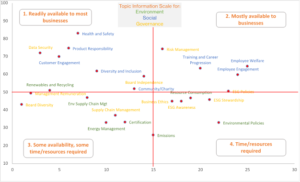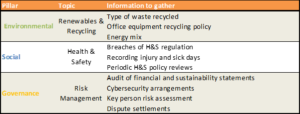For most businesses, starting the ESG journey is a daunting task, often delayed by management due to a poor understanding of the sort of information needed, where to find it and how much detail is required in order to ‘pass the test’. The sense of helplessness is compounded by rising pressure from counterparties and stakeholders to produce a coherent set of answers. The question most commonly asked is – how do we start? What’s already in your ESG locker?
The simple answer is: start at home…
…by taking small steps:
Sustainability is not about learning to perform, it’s about building a clear understanding of a business’s impact on the environment, its values and its conduct. This is not achieved in the first draft, but over time, using policies and data that may already exist within the firm’s information resources, but that require building a structure around.
What information do I start with? Or – what information do you already have?
Many businesses don’t recognise what constitutes ESG within their operations, because the components are simply seen as BAU, and the data has been disaggregated, making it hard to join the dots. In addition, even if they have the data, they feel it isn’t complete enough to use. The best way to get over the hurdle is to start with what you’ve got, whatever it might be and grow from there.
Assess information availability:
Our research highlights that businesses will nearly always have the answers to a few core questions in the Environmental, Social and Governance categories – enough to begin the process and to build from there to provide sensible disclosure. When we divide up ESG topics into ‘areas of difficulty’ using available company data based on targeting and information gathering, we can see in the different quadrants where gathering the required information is quite simple (Top Left), and where resources and time will be required to secure the information (Bottom Right).

Source: TDH analysis/TDH survey data
Type of information to collect:
Examples of the type of existing information in some of the easier topics might include (but not limited to):

Source: TDH Survey and Research
Decide on targets:
Once the information for the selected topics has been consolidated, the process of targeting improvement is simplified. In general the topics in the upper left quadrant can be measured over a shorter time period and more economically than those in the lower right quadrant, which tend to emerge over time and involve more strategic action.
With a simple set of tools to help catalogue existing sustainability credentials it is possible to build, demonstrate and eventually influence businesses in your value chain to adopt similar standards which, in itself achieves one of the most significant aims of the UN SDGs: Goal 17: Supporting the Partnership for Sustainable Goals.
To learn more about how The Disruption House can help your business, click here.


